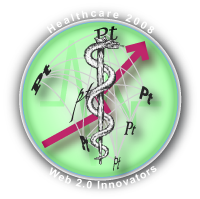Collaborating with Customers to Achieve Corporate Strategy—How Small Steps Can Lead to Large Impact
 Healthcare systems worldwide are criticized for falling short of expectations, and countries like the U.S. which feature aging populations, are rapidly approaching a crisis. Demand and cost will grow, but the system as currently structured will certainly break down unless radical changes are made. Web 2.0’s disruptive potential can be part of the remedy: we need to introduce much more accountability and collaboration into all parts of the system. We need to change the paternalistic attitudes that pervade the system, treat patients as active participants and encourage everyone to be more accountable. This series introduces healthcare Web 2.0 innovators.
Healthcare systems worldwide are criticized for falling short of expectations, and countries like the U.S. which feature aging populations, are rapidly approaching a crisis. Demand and cost will grow, but the system as currently structured will certainly break down unless radical changes are made. Web 2.0’s disruptive potential can be part of the remedy: we need to introduce much more accountability and collaboration into all parts of the system. We need to change the paternalistic attitudes that pervade the system, treat patients as active participants and encourage everyone to be more accountable. This series introduces healthcare Web 2.0 innovators.
CDC Business Drivers
CDC’s charter is to protect public health. The agency serves as a resource to mitigate the impact of infectious diseases, environmental health, bioterrorism and others. It fulfils its mission by connecting with people and educating the public; it seeks to partner with people to increase their knowledge of health hazards and how to respond appropriately in the face of threats.
Summary of Web 2.0 Activities
 CDC perceives that social networking and other Web 2.0 activities are critical to its mission. According to Janice Nall, National Center for Health Marketing, “You have to be where the people are.. we want CDC content available whenever, wherever and however people want it.”
CDC perceives that social networking and other Web 2.0 activities are critical to its mission. According to Janice Nall, National Center for Health Marketing, “You have to be where the people are.. we want CDC content available whenever, wherever and however people want it.”
Nall also advises to approach Web 2.0 with your eyes wide open. If you have to, start small and build. Acknowledge uncertainty. Realize that you will make mistakes, but the error of not being there is far greater than making small mistakes when you are on the learning curve.
How CDC Uses Web 2.0
CDC uses Web 2.0 in three key ways: to interact with people, to learn from people and to let people use and share CDC content. CDC learns considerably by interacting with people directly and by observing how they are interacting among each other. They want to prevent misinformation by making their content available wherever and however people are talking about health issues.
Select Web 2.0 Initiatives
- Podcasting—podcasting is easy to produce, and it is easy for people to share and access. CDC has produced podcasts on: influenza pandemics, climate change, STD treatment guidelines and bioterrorism.
- eCards—eCards are very social, easy to do and produce surprising results. The “cards” enable CDC to understand what is on people’s minds. CDC eCards are growing quickly as people send each other reminders for immunizations, annual check-ups, etc.
- Gaming—CDC has created several games, most aimed toward younger audiences. There are games involving immunizations, for nutrition and obesity, exercise promotion. Games are an excellent means to engage and educate.
- Virtual worlds—CDC has a presence in Second Life. Do not forget to start small and grow.
- Mobile—more Americans have mobile phones than wireline phones, and CDC has executes several mobile campaigns, which are very engaging. Most involved sharing via text messages and short codes. In another, people made “personal” public service announcements
Lessons Learned
- Follow the user – know the usage data/trends
- Show how this meets your mission
- Compare resources vs. impact
- Keep security, IT and legal aware of initiatives
- Plan for evaluation
- Conduct research where you can
- Welcome collaboration – partner outside/inside
- Seed social media concepts through training
- Document lessons learned
- Educate leadership on why you must do this
- Create a climate of experimentation

[…] post CDC: Healthcare Web 2.0 Innovator Case Study appeared first on Christopher S. Rollyson and […]